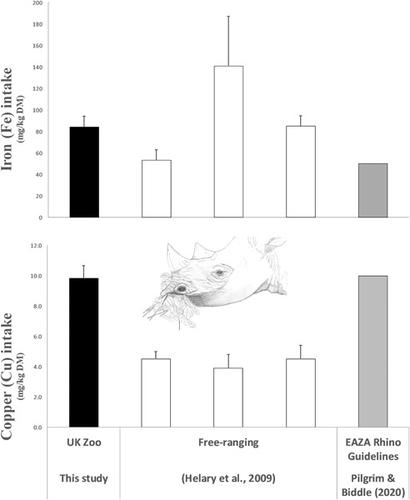Our official English website, www.x-mol.net, welcomes your feedback! (Note: you will need to create a separate account there.)
Feed intake and dietary composition of iron (Fe), copper (Cu), vitamin E, and tannic acid of five captive black rhinoceros ( Diceros bicornis ) in a UK collection
Zoo Biology ( IF 1.3 ) Pub Date : 2020-11-02 , DOI: 10.1002/zoo.21580 Victoria Ricketts 1 , Ellen S. Dierenfeld 1, 2 , Cathrine Sauer 3, 4 , Katherine Whitehouse‐Tedd 1
Zoo Biology ( IF 1.3 ) Pub Date : 2020-11-02 , DOI: 10.1002/zoo.21580 Victoria Ricketts 1 , Ellen S. Dierenfeld 1, 2 , Cathrine Sauer 3, 4 , Katherine Whitehouse‐Tedd 1
Affiliation

|
The black rhinoceros (Diceros bicornis) is a critically endangered species facing multiple anthropogenic pressures in its natural home range across Africa. Black rhinoceros are difficult to maintain ex situ and subject to diseases that are linked with captive dietary factors. Hemochromatosis is of particular concern, as it is a common finding at necropsy of captive adults, and has been linked to excessive dietary iron intake. This intake study investigates the select nutrient composition of the diets offered to and consumed by five captive black rhinoceros in a UK zoo to evaluate, ensure adequacy, and/or make adjustments if necessary. Alfalfa hay, pellets and six browse species offered were analyzed for iron (Fe), copper (Cu), vitamin E, and tannic acid content. Intakes were quantified and evaluated against levels found in wild diets and the currently available feeding guidelines for black rhinoceros. Diets eaten by five individual rhinoceros (1.4%-2.3% of bodyweight dry matter [DM] intake), comprising 68%-82% hay, 6%-13% pellets, and 13%-27% browse, contained 76-98 mg/kg Fe (on a DM basis), fell within the ranges of plants eaten by free-ranging rhinoceros (45-140 mg/kg DM), as well as values recommended for captive-fed browsing rhinoceros (50-100 mg/kg DM). Consumed diets were found to be marginal to adequate in Cu (9-11 mg/kg DM) compared with the recommended 10 mg/kg DM; dietary vitamin E ranged from 54 to 79 IU/kg DM, and tannic acid measured 13-14 g/kg DM. Commercial pellets were the primary contributor of dietary Fe, Cu, and vitamin E, containing up to 10 times more of each of those nutrients than the forages. Native browses were important sources of lower Fe ingredients, as well as appropriate levels of dietary Cu and vitamin E (dependent on species). Interestingly, pellets (23 g/kg) and alfalfa hay (14 g/kg) contained higher concentrations of tannic acid compared with any of the browses fed (4-13 g/kg). All nutritional parameters evaluated were close to recommended dietary levels, diets resembled values consumed in the wild, and the animals remained clinically healthy throughout the study. Overall, diets were considered nutritionally adequate for captive feeding of black rhinoceros; evaluating the nutrient composition of all ingredients, including browse plants in diets, provides important information for achieving optimal nutrient balance.
中文翻译:

英国收集的五只圈养黑犀牛 (Diceros bicornis) 的铁 (Fe)、铜 (Cu)、维生素 E 和单宁酸的饲料摄入量和膳食成分
黑犀牛(Diceros bicornis)是一种极度濒危的物种,在其整个非洲的自然栖息地面临多种人为压力。黑犀牛很难在异地饲养,并且容易受到与圈养饮食因素有关的疾病的影响。血色病尤其值得关注,因为它是圈养成年人尸体剖检时的常见发现,并且与膳食铁摄入过多有关。该摄入量研究调查了英国动物园中五头圈养黑犀牛提供和食用的饮食的特定营养成分,以评估、确保充足性和/或在必要时进行调整。分析了苜蓿干草、颗粒和六种草料的铁 (Fe)、铜 (Cu)、维生素 E 和单宁酸含量。根据野生饮食中发现的水平和目前可用的黑犀牛喂养指南对摄入量进行量化和评估。五头犀牛的饮食(占体重干物质 [DM] 摄入量的 1.4%-2.3%),包括 68%-82% 的干草、6%-13% 的颗粒和 13%-27% 的饲料,含有 76-98 毫克/kg Fe(以干物质为基础),属于自由放养犀牛食用的植物范围(45-140 毫克/千克干物质),以及圈养食草犀牛的推荐值(50-100 毫克/千克) DM)。与推荐的 10 mg/kg DM 相比,发现消耗的饮食中的 Cu(9-11 mg/kg DM)微不足道;膳食维生素 E 的范围为 54 至 79 IU/kg DM,单宁酸的范围为 13-14 g/kg DM。商业颗粒是膳食铁、铜和维生素 E 的主要贡献者,每种营养物质的含量是草料的 10 倍。本地粗粮是低铁成分以及适当水平的膳食铜和维生素 E(取决于物种)的重要来源。有趣的是,颗粒(23 克/千克)和苜蓿干草(14 克/千克)与任何饲喂的粗饲料(4-13 克/千克)相比含有更高浓度的单宁酸。评估的所有营养参数都接近推荐的饮食水平,饮食类似于野外消耗的值,并且动物在整个研究过程中保持临床健康。总体而言,饮食被认为营养充足,适合圈养黑犀牛;评估所有成分的营养成分,包括饮食中的植物,为实现最佳营养平衡提供重要信息。本地粗粮是低铁成分以及适当水平的膳食铜和维生素 E(取决于物种)的重要来源。有趣的是,颗粒(23 克/千克)和苜蓿干草(14 克/千克)与任何饲喂的粗饲料(4-13 克/千克)相比含有更高浓度的单宁酸。评估的所有营养参数都接近推荐的饮食水平,饮食与野外消耗的值相似,并且动物在整个研究过程中保持临床健康。总体而言,饮食被认为营养充足,适合圈养黑犀牛;评估所有成分的营养成分,包括饮食中的植物,为实现最佳营养平衡提供重要信息。本地粗粮是低铁成分以及适当水平的膳食铜和维生素 E(取决于物种)的重要来源。有趣的是,颗粒(23 克/千克)和苜蓿干草(14 克/千克)与任何饲喂的粗饲料(4-13 克/千克)相比含有更高浓度的单宁酸。评估的所有营养参数都接近推荐的饮食水平,饮食与野外消耗的值相似,并且动物在整个研究过程中保持临床健康。总体而言,饮食被认为营养充足,适合圈养黑犀牛;评估所有成分的营养成分,包括饮食中的植物,为实现最佳营养平衡提供重要信息。以及适当水平的膳食铜和维生素 E(取决于物种)。有趣的是,颗粒(23 克/千克)和苜蓿干草(14 克/千克)与任何饲喂的粗饲料(4-13 克/千克)相比含有更高浓度的单宁酸。评估的所有营养参数都接近推荐的饮食水平,饮食与野外消耗的值相似,并且动物在整个研究过程中保持临床健康。总体而言,饮食被认为营养充足,适合圈养黑犀牛;评估所有成分的营养成分,包括饮食中的植物,为实现最佳营养平衡提供重要信息。以及适当水平的膳食铜和维生素 E(取决于物种)。有趣的是,颗粒(23 克/千克)和苜蓿干草(14 克/千克)与任何饲喂的粗饲料(4-13 克/千克)相比含有更高浓度的单宁酸。评估的所有营养参数都接近推荐的饮食水平,饮食与野外消耗的值相似,并且动物在整个研究过程中保持临床健康。总体而言,饮食被认为营养充足,适合圈养黑犀牛;评估所有成分的营养成分,包括饮食中的植物,为实现最佳营养平衡提供重要信息。评估的所有营养参数都接近推荐的饮食水平,饮食与野外消耗的值相似,并且动物在整个研究过程中保持临床健康。总体而言,饮食被认为营养充足,适合圈养黑犀牛;评估所有成分的营养成分,包括饮食中的植物,为实现最佳营养平衡提供重要信息。评估的所有营养参数都接近推荐的饮食水平,饮食类似于野外消耗的值,并且动物在整个研究过程中保持临床健康。总体而言,饮食被认为营养充足,适合圈养黑犀牛;评估所有成分的营养成分,包括饮食中的植物,为实现最佳营养平衡提供重要信息。
更新日期:2020-11-02
中文翻译:

英国收集的五只圈养黑犀牛 (Diceros bicornis) 的铁 (Fe)、铜 (Cu)、维生素 E 和单宁酸的饲料摄入量和膳食成分
黑犀牛(Diceros bicornis)是一种极度濒危的物种,在其整个非洲的自然栖息地面临多种人为压力。黑犀牛很难在异地饲养,并且容易受到与圈养饮食因素有关的疾病的影响。血色病尤其值得关注,因为它是圈养成年人尸体剖检时的常见发现,并且与膳食铁摄入过多有关。该摄入量研究调查了英国动物园中五头圈养黑犀牛提供和食用的饮食的特定营养成分,以评估、确保充足性和/或在必要时进行调整。分析了苜蓿干草、颗粒和六种草料的铁 (Fe)、铜 (Cu)、维生素 E 和单宁酸含量。根据野生饮食中发现的水平和目前可用的黑犀牛喂养指南对摄入量进行量化和评估。五头犀牛的饮食(占体重干物质 [DM] 摄入量的 1.4%-2.3%),包括 68%-82% 的干草、6%-13% 的颗粒和 13%-27% 的饲料,含有 76-98 毫克/kg Fe(以干物质为基础),属于自由放养犀牛食用的植物范围(45-140 毫克/千克干物质),以及圈养食草犀牛的推荐值(50-100 毫克/千克) DM)。与推荐的 10 mg/kg DM 相比,发现消耗的饮食中的 Cu(9-11 mg/kg DM)微不足道;膳食维生素 E 的范围为 54 至 79 IU/kg DM,单宁酸的范围为 13-14 g/kg DM。商业颗粒是膳食铁、铜和维生素 E 的主要贡献者,每种营养物质的含量是草料的 10 倍。本地粗粮是低铁成分以及适当水平的膳食铜和维生素 E(取决于物种)的重要来源。有趣的是,颗粒(23 克/千克)和苜蓿干草(14 克/千克)与任何饲喂的粗饲料(4-13 克/千克)相比含有更高浓度的单宁酸。评估的所有营养参数都接近推荐的饮食水平,饮食类似于野外消耗的值,并且动物在整个研究过程中保持临床健康。总体而言,饮食被认为营养充足,适合圈养黑犀牛;评估所有成分的营养成分,包括饮食中的植物,为实现最佳营养平衡提供重要信息。本地粗粮是低铁成分以及适当水平的膳食铜和维生素 E(取决于物种)的重要来源。有趣的是,颗粒(23 克/千克)和苜蓿干草(14 克/千克)与任何饲喂的粗饲料(4-13 克/千克)相比含有更高浓度的单宁酸。评估的所有营养参数都接近推荐的饮食水平,饮食与野外消耗的值相似,并且动物在整个研究过程中保持临床健康。总体而言,饮食被认为营养充足,适合圈养黑犀牛;评估所有成分的营养成分,包括饮食中的植物,为实现最佳营养平衡提供重要信息。本地粗粮是低铁成分以及适当水平的膳食铜和维生素 E(取决于物种)的重要来源。有趣的是,颗粒(23 克/千克)和苜蓿干草(14 克/千克)与任何饲喂的粗饲料(4-13 克/千克)相比含有更高浓度的单宁酸。评估的所有营养参数都接近推荐的饮食水平,饮食与野外消耗的值相似,并且动物在整个研究过程中保持临床健康。总体而言,饮食被认为营养充足,适合圈养黑犀牛;评估所有成分的营养成分,包括饮食中的植物,为实现最佳营养平衡提供重要信息。以及适当水平的膳食铜和维生素 E(取决于物种)。有趣的是,颗粒(23 克/千克)和苜蓿干草(14 克/千克)与任何饲喂的粗饲料(4-13 克/千克)相比含有更高浓度的单宁酸。评估的所有营养参数都接近推荐的饮食水平,饮食与野外消耗的值相似,并且动物在整个研究过程中保持临床健康。总体而言,饮食被认为营养充足,适合圈养黑犀牛;评估所有成分的营养成分,包括饮食中的植物,为实现最佳营养平衡提供重要信息。以及适当水平的膳食铜和维生素 E(取决于物种)。有趣的是,颗粒(23 克/千克)和苜蓿干草(14 克/千克)与任何饲喂的粗饲料(4-13 克/千克)相比含有更高浓度的单宁酸。评估的所有营养参数都接近推荐的饮食水平,饮食与野外消耗的值相似,并且动物在整个研究过程中保持临床健康。总体而言,饮食被认为营养充足,适合圈养黑犀牛;评估所有成分的营养成分,包括饮食中的植物,为实现最佳营养平衡提供重要信息。评估的所有营养参数都接近推荐的饮食水平,饮食与野外消耗的值相似,并且动物在整个研究过程中保持临床健康。总体而言,饮食被认为营养充足,适合圈养黑犀牛;评估所有成分的营养成分,包括饮食中的植物,为实现最佳营养平衡提供重要信息。评估的所有营养参数都接近推荐的饮食水平,饮食类似于野外消耗的值,并且动物在整个研究过程中保持临床健康。总体而言,饮食被认为营养充足,适合圈养黑犀牛;评估所有成分的营养成分,包括饮食中的植物,为实现最佳营养平衡提供重要信息。



























 京公网安备 11010802027423号
京公网安备 11010802027423号